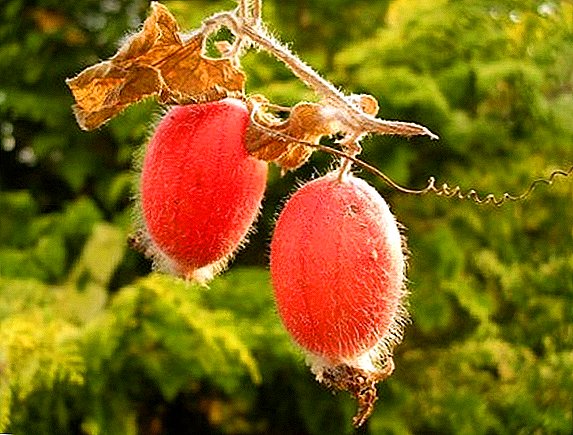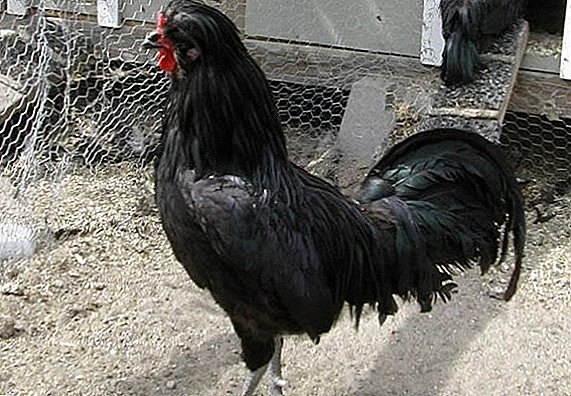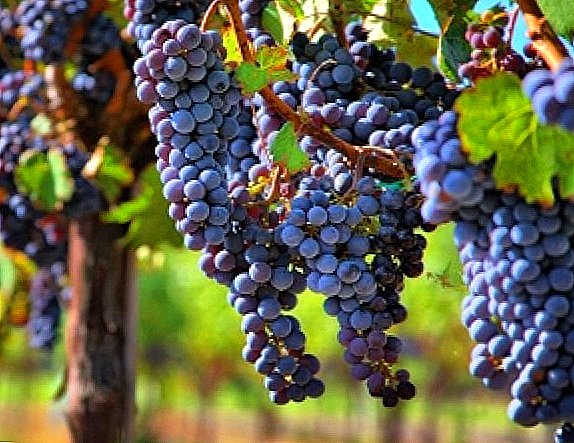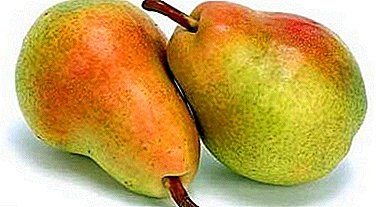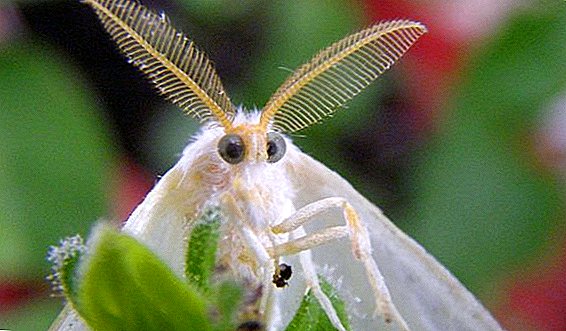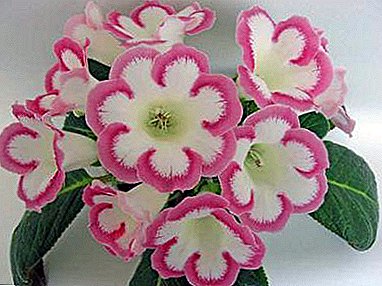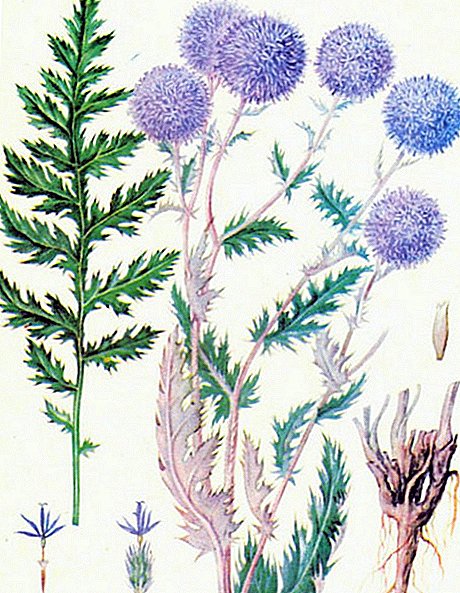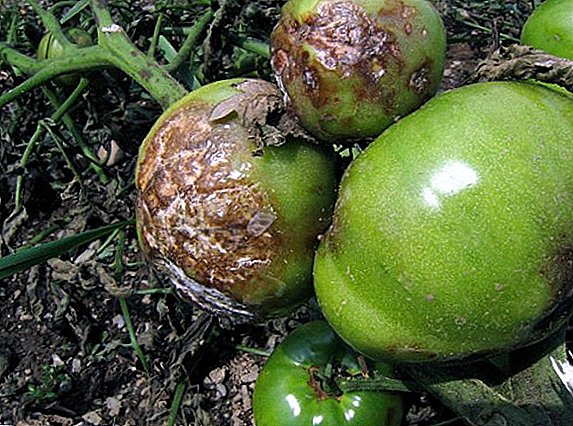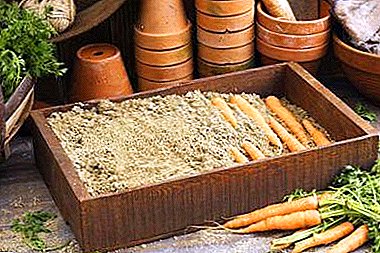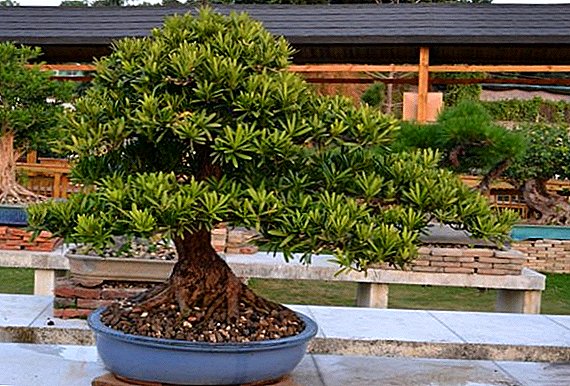 Bonsai is the Japanese and Chinese art of growing miniature landscapes in flat pots consisting of single evergreen conifers or other trees. Subocarpuses are often used for this purpose. In this article we will look at how to grow, maintain and care for these miniature trees at home.
Bonsai is the Japanese and Chinese art of growing miniature landscapes in flat pots consisting of single evergreen conifers or other trees. Subocarpuses are often used for this purpose. In this article we will look at how to grow, maintain and care for these miniature trees at home.
Botanical description
Dwarf bonsai trees Podocarpus (Bonsai Podocarpus), grown in trays, are evergreen slowly growing trees. There is another name - footpods. They are divided into nineteen genera, among which there are almost two hundred species of trees.  There is a huge variety of shapes and sizes of these ornamental plants. Usually - it is a tree or shrubs, growing from half a meter, reaching a height of two meters.
There is a huge variety of shapes and sizes of these ornamental plants. Usually - it is a tree or shrubs, growing from half a meter, reaching a height of two meters.
Podocarpus are conifers, close relatives of subocarpus are cypress, cedar, thuja, larch, pine, spruce, araucaria, fir, microbiota, hemlock, yew, juniper.The bark on the footpods is dark gray, first rough and homogeneous to the touch, and later, with age, it cracks and in some places collapses. The branches and stems are straight, also stiffen with age. Dark green leaves are not needle-shaped, but in the form of straps, linear, but may be oval-shaped. In length reach 7-15 cm and 10 cm in width. They have a glossy shine on the front side.
The arrangement of leaves on the branches of some subocarpuses goes in a spiral, in others - in two rows horizontally. Trees bloom with candle-shaped flowers of both sexes, but some species are monoecious flowers. At home, flowering and fruit formation usually does not happen, but even without them, trees look decorative and attractive.  Some of the feet are grown in the garden, and their berries are considered edible. Fruits are reddish, bluish or purple, they are suitable for consumption as a raw or boiled. The taste of the fruit is sweet, with a sticky inside.
Some of the feet are grown in the garden, and their berries are considered edible. Fruits are reddish, bluish or purple, they are suitable for consumption as a raw or boiled. The taste of the fruit is sweet, with a sticky inside.
Despite the attractive appearance and taste, they have some toxicity, so they need to be eaten sparingly. In traditional Asian medicine, they are widely used.
Did you know? The oldest bonsai is over 500 years old. He was named "Imperial third generation Tokugawa pine". The documents testify that Emperor Tokugawa Iemitsu (reigned 1623-1651) began cultivating him, after which the tree was passed down to each subsequent head of Japan.
 Podocarp berries
Podocarp berriesLearn how to grow cypress, fir, juniper, spruce in a pot.
Spread
The mastery of the cultivation of dwarf subocarpuses in ancient China was conceived two thousand years ago, and six hundred years later, with the emergence of Buddhism in Japan, it migrated to this country, adopting a more refined and philosophical form. In this country, it is believed that the author who creates such a composition must necessarily have a number of spiritual qualities: a sense of justice, wisdom, goodwill and delicacy.
About a hundred species of these trees have spread throughout the world. The favorite places where the subcarpathus grow are the southern mountains with a tropical climate (south of New Zealand and Chile), the northern direction (from Japan to Mexico), and Southeast Africa, where, by the way, they are mercilessly cut down and today are on the verge of complete destruction.
Home application
In Japan, family bonsai podocarpus are grown, thereby passing them on to future generations. Representatives of home interior can live for hundreds of years, so they often become heirlooms.
Locals believe that these small trees, if properly placed in the house, can powerfully influence energy flows. They believe that if you follow the Taoist tradition of symbolic organization of space (Feng Shui), then you can lead these flows and direct them in the right direction.
Find out what styles to form bonsai.
Maintenance and care at home
Before you start growing a houseplant, you need to consider some important factors:
- This occupation is very long and difficult, so to grow a full-fledged tree, you need at least 4 years - that is how long it takes to germinate seeds and form a strong stem.
- Experts do not recommend forcibly turning ordinary plants into dwarfs: for growing miniature trees, it is better to buy grown-up plants of the required size or use seeds for this.
- It is preferable to choose a large-leaved footplant, Nagi, Totara.
Did you know? The most ancient trees-long-livers are redwoods - today there are some plants that are 4,000 years old.
Choosing a place
Like any other plant, indoor bonsai need enough fresh air as well as good lighting. Otherwise, these are not very fastidious plants that can be successfully grown on verandas or balconies, choosing a place for them with a short period of exposure to the direct rays of the sun and the optimum temperature for their growth. Foot fruits are heat-loving plants, so the optimum temperature for them is:
Foot fruits are heat-loving plants, so the optimum temperature for them is:
- in summer - no more than +20 ° С;
- in winter - from +6 to +15 ° С: if the winter temperature exceeds these figures, then the feet can die.
There are trees specially created for apartment conditions, so they are less demanding to care and more durable, although they also need high humidity, they should be kept away from heaters. Another important factor in the cultivation of miniature trees at home is that they do not tolerate drafts.
Learn what are the general rules for growing bonsai from different plants.It is important to remember that in our temperate latitudes, the days are shorter than in the tropics, where leg-fruit grow in nature. Therefore, it is important to create for them additional sources of illumination, especially in winter. It should be noted that the different tree species used for bonsai have different needs for the amount of lighting, as well as different requirements for their placement. Therefore, it is advisable to check with the experts or vendors in the store all these nuances.
Watering and moisture
During the formation of the plant, he needs frequent watering, while not filling the earthen room. The soil should be constantly moistened, even in winter.  Podocarpus loves constantly wet soil. In winter, it does not need to subject the tree to frequent spraying with a spray gun, but a periodic warm shower will be appropriate (all these nuances apply to plants in room conditions).
Podocarpus loves constantly wet soil. In winter, it does not need to subject the tree to frequent spraying with a spray gun, but a periodic warm shower will be appropriate (all these nuances apply to plants in room conditions).
In summer, watering and spraying should be more abundant. If you allowed the land to dry out in a flowerpot, then you need to place it in a large container and pour water there so that the earth in the flowerpot is saturated with moisture.
Important! Water the feet of ordinary tap water, previously settled for 24 hours to get rid of chlorine impurities.
Soil and feeding
For dwarf leg-growers need special moisture-intensive and loose earth. It is best to acquire soil suitable for planting miniature trees in specialized stores. To maintain optimal plant growth, a drainage layer is also needed.
You need to feed trees in the summer during the period of active growth, at least 1 time per month. In winter, top dressing should be moderate. To do this, use liquid fertilizer for coniferous plants: the recommended dose is diluted in water, and the resulting solution is watered with an earthen clod.
You can use both organic and inorganic dressings. Twice a year you need to feed a small amount of iron chelate.
Transfer
Replace footplant rarely and only when the tree needs it. Usually this procedure is performed in the spring.  Subocarpus transplantation is carried out from November to March, along with cutting the bottom of the roots Here are some recommendations for transplanting dwarf trees:
Subocarpus transplantation is carried out from November to March, along with cutting the bottom of the roots Here are some recommendations for transplanting dwarf trees:
- If these are young specimens, then they should be replanted every year into a larger pot, and mature trees once a few years (2-4 years).
- It is best to do the transshipment of trees, so as not to disturb the mycelium of the mushrooms useful for the footpod.
- When transplanting, one-third of the roots are cut off, and the plant is immersed in a neutral substrate: the soil for transshipment should consist of the humus of coniferous bark, with the addition of soil and sand.
Crown formation and shearing
The best way to stimulate the growth of miniature trees is to regularly cut the crown and twigs.
Bonsai are also formed from a ficus of microcarp, boxwood, pyracanthus, Benjamin ficus, cryptomeria, Murayi, Tolstians, adeniums.Bonsai trees are cut in two ways:
- Regular haircut to maintain the existing shape.
- Trimming to create style and shape of bonsai.
 To prevent these processes, you need to carefully trim the tops and side shoots with scissors so that the plants later redistribute nutrients to the inner and lower parts of the crown.
To prevent these processes, you need to carefully trim the tops and side shoots with scissors so that the plants later redistribute nutrients to the inner and lower parts of the crown.Do not be afraid to regularly cut their trees, this procedure should be carried out during the entire period of their growth. This will cause the trees to grow more evenly and develop dense foliage. If it is a coniferous tree, then it is not necessary to trim it, but it is best to pluck it manually.
Important! To bonsai tree after pruning quickly recovered and does not hurt, it is important to lubricate the sections with a special mixture for their processing.When creating a style and form, you need to consider a few basic rules:

- To start, think and observe your tree to determine its future shape.
- Create as low as possible bonsai with perfect proportions: the height of the plant and the thickness of the trunk should be in a ratio of 1: 7 (for example, a trunk with a diameter of 3 cm and a height of 21 cm).
- The top of the tree should be directed only upwards.
- For a start, sturdier and longer shoots are cut, as they are more difficult to direct and shape.
- The growth of the side branches should strive strictly to the side.
- The branches in the foreground of the bonsai are removed, and only small ones should be left on the top of the crown.
- Bush can only the lower part of the crown.
- The lowest part of the trunk is left without branches (about one third).
- The main branch is directed to grow as low as possible.
- Branches that grow at the same height and are located opposite each other on both sides of the trunk, it is better to cut. The same applies to branches located very close.
- When viewed from above, the placement of the branches should be such that some do not overlap others.
- After shearing the tree should look "poorer" than before.
- Considering the fact that pruning is a painful procedure for a plant, he needs a 2-month rest before the next procedure.

Reproduction by cuttings
For reproduction of dwarf legted fruit, the following actions are carried out in spring or summer:
- It is necessary to build a special greenhouse for growing seedlings and maintain a constant warm temperature (not lower than + 18-20 ° C).
- To ignite the sand on the stove, let it cool and pour it into the prepared container for germinating the cuttings.
- From a healthy tree, cut off a stalk with a length of 10-15 cm or carefully cut it straight from the heel.
- To powder a shoot with root stimulator and to plant in capacity with sand.
- Phytohormones of growth must be added to the soil.
- Mandatory bottom heating of the soil.
Learn how to propagate by cuttings of blue spruce, tui, fir.As you can see, it is quite difficult to grow bonsai at home, it is a long process, so this issue needs a creative approach. Indeed, in nature, conifers grow for a very long time, and their dwarf analogs are no exception. Because of this, you need to gain a lot of patience, and then it will be possible to achieve the desired result.
Video: Bonsai Podocarpus
How to grow Podocarpus: reviews
Temperature: in the summer of 17-23C, in the winter it is desirable to keep in a bright place at a temperature of about 15C.
Watering: moderate, with a cool content in the winter cautious. Do not allow complete drying out and waterlogging of the substrate.
Humidity: high. This is one of the main problems with growing this plant. It suffers greatly from dry air. Therefore, it is necessary to apply measures aimed at increasing the humidity of the air - use humidifiers, place the plant pot on a tray filled with wet claydite, do not place near heating appliances. Spray only with soft water at room temperature.
Top dressing: monthly during the active growing season. The rate of fertilizer can be reduced in comparison with the recommended.

On the one hand, the beginning of growth indicates rooting, and with the side arc, the stalk sits in a tiny transparent cup and the roots are not visible. And the question is: is it possible to try to remove the cover from him, so that he would begin to live independently, or even while he lives in greenhouse conditions? In the sense that there is even the slightest hope that he still has tiny roots there?




